Ammonia poisoning is a silent and deadly disease that can affect your bettas, and if not caught in time, it can kill them. Typically, ammonia poisoning happens when you are setting up a new (non-established) tank. But it can also occur in established aquariums that have had their nitrogen cycling process interrupted.
Just like humans, excessive ammonia causes serious burns on a betta’s skin, eyes, fins, and gills.
No need to panic! With quick treatment, your betta fish usually recover well from this condition within a week.
Keep reading as we explain the nitrogen cycle, several different causes of betta ammonia poisoning, and the signs you need to look out for to keep your fish healthy and safe in this guide.
The Nitrogen Cycle Explained
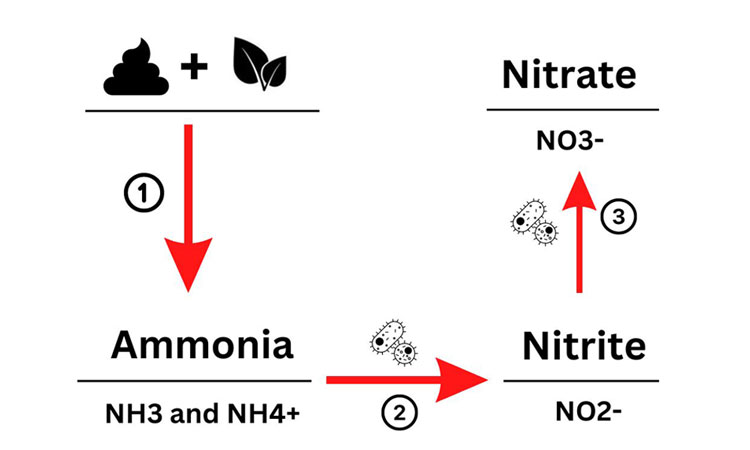
In order to prevent and fight betta ammonia poisoning, you will need to understand more about the nitrogen cycle in an aquarium.
Simply put, the aquarium nitrogen cycle describes how toxic nitrogen compounds like fish waste and other decomposing organic matter in the water get degraded from ammonia to nitrites to nitrates.
The final nitrates are then either converted to free nitrogen gas and removed by way of regular water changes or taken up by aquarium plants and microorganisms (also known as beneficial bacteria).
Unlike the natural nitrogen cycle that occurs in large bodies of water, closed aquariums require their own nitrogen cycle, which must be carefully established and fostered.
What is a Safe Ammonia Level for Betta Fish?
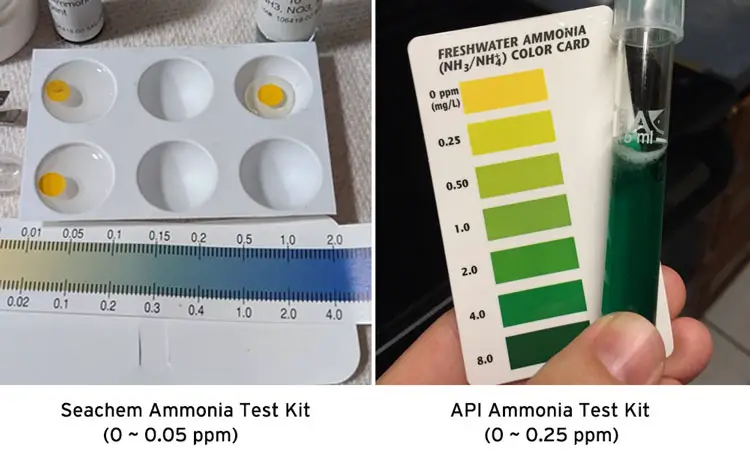
Ideally, the ammonia level in any aquarium should always be 0 ppm. In reality, it isn’t always practical because of the decomposition of biological waste, elevated ph levels, bacterial colonies dying, etc.
So, aside from saying 0 is the ideal number, what is practically safe?
Unfortunately, the answer isn’t crystal clear. While some aquarists say it depends on what test kit you use.
The readily available API Ammonia Test Kit, for example, shows a safe ammonia range for fish that falls between 0 ppm and 0.25 ppm. Another popular Ammonia Test Kit from Seachem, who has a reputation for being the most knowledgeable manufacturer on the market, has the next level of awareness from 0 to 0.05 ppm.
You may wonder why the Seachem Ammonia Alert requires action at such a lower ammonia level. Although there is no easy answer to this question, one thing is certain: knowing the toxicity of ammonia can help you understand the actual ammonia level in your tank.
What is Ammonia Poisoning (Toxicity) in Fish?
In a typical aquarium, the majority of ammonia is excreted by fish as a byproduct of protein metabolism, mainly through the gills and in small amounts in their urine or across other tissues. It can also be produced naturally from the breakdown of organic matter (OM) and uneaten food.
Ammonia exists in water in two chemical forms: un-ionized ammonia (NH3 or UIA) and ionized ammonia (NH4+). In most tests for ammonia, both forms are measured together, referred to as total ammonia nitrogen (TAN).
Since the ionized NH4+ doesn’t easily cross fish gills and has poor bioavailability, it’s basically harmless to fish or other aquatic organisms, whereas un-ionized NH3 can cross the gill membranes very easily and shift to ionized form (NH4+), causing cellular damage and death.
So, the “free” or gaseous NH3 is the highly toxic form we worry about. The presence of as low as 0.02 – 0.05 ppm [1] of NH3 can be deadly to fish.

Generally, these two ammonia forms exist at an equilibrium point that is influenced largely by water pH and temperature. As pH or temperature increases, the ratio of NH3 to NH4 + increases, meaning that ammonia becomes more toxic.
Several studies have found that the proportion of NH3 to NH4+ (or ammonia toxicity) is also in relation to the salinity of the water [2]. In some cases, making the water harder can reduce ammonia toxicity. That’s why saltwater fish are slightly more sensitive to ammonia toxicity than freshwater species.
Back to the above question, you probably already know why the Seachem test kit warns at ammonia levels of 0.05ppm and less because unlike API Ammonia Test Kit tests the total ammonia nitrogen (TAN), it only measures the gaseous, un-ionized ammonia (NH3 or UIA).
Getting Accurate Ammonia Level Test Results
Although the Seachem is the only gas sensor test kit on the market that gives you an accurate reading of free ammonia (NH3 or UIA), it’s not exactly easy to use.
Author notes: It comes with a reagent that allows you to perform a total ammonia nitrogen (TAN) test, but it can be quite tedious and time-consuming.
Personally, I use the API ammonia liquid test kit, as it’s much easier and faster. But to get the most accurate ammonia level readings, I followed a step-by-step guide and Ammonia Toxicity Table developed by the University of Florida [3], which gives me peace of mind when I’ve gotten too busy to test.
Here is a step-by-step guide and an example of calculating un-ionized ammonia with the API ammonia test kit or other test kits that measure total ammonia nitrogen (TAN).

| Temperature | |||||||||||||||
|---|---|---|---|---|---|---|---|---|---|---|---|---|---|---|---|
| pH | 42.0(°F) | 46.4 | 50.0 | 53.6 | 57.2 | 60.8 | 64.4 | 68.0 | 71.6 | 75.2 | 78.8 | 82.4 | 86.0 | 89.6 | |
| 6(°C) | 8 | 10 | 12 | 14 | 16 | 18 | 20 | 22 | 24 | 26 | 28 | 30 | 32 | ||
| 7.0 | .0013 | .0016 | .0018 | .0022 | .0025 | .0029 | .0034 | .0039 | .0046 | .0052 | .0060 | .0069 | .0080 | .0093 | |
| 7.2 | .0021 | .0025 | .0029 | .0034 | .0040 | .0046 | .0054 | .0062 | .0072 | .0083 | .0096 | .0110 | .0126 | .0150 | |
| 7.4 | .0034 | .0040 | .0046 | .0054 | .0063 | .0073 | .0085 | .0098 | .0114 | .0131 | .0150 | .0173 | .0198 | .0236 | |
| 7.6 | .0053 | .0063 | .0073 | .0086 | .0100 | .0116 | .0134 | .0155 | .0179 | .0206 | .0236 | .0271 | .0310 | .0369 | |
| 7.8 | .0084 | .0099 | .0116 | .0135 | .0157 | .0182 | .0211 | .0244 | .0281 | .0322 | .0370 | .0423 | .0482 | .0572 | |
| 8.0 | .0133 | .0156 | .0182 | .0212 | .0247 | .0286 | .0330 | .0381 | .0438 | .0502 | .0574 | .0654 | .0743 | .0877 | |
| 8.2 | .0210 | .0245 | .0286 | .0332 | .0385 | .0445 | .0514 | .0590 | .0676 | .0772 | .0880 | .0998 | .1129 | .1322 | |
| 8.4 | .0328 | .0383 | .0445 | .0517 | .0597 | .0688 | .0790 | .0904 | .1031 | .1171 | .1326 | .1495 | .1678 | .1948 | |
| 8.6 | .0510 | .0593 | .0688 | .0795 | .0914 | .1048 | .1197 | .1361 | .1541 | .1737 | .1950 | .2178 | .2422 | .2768 | |
| 8.8 | .0785 | .0909 | .1048 | .1204 | .1376 | .1566 | .1773 | .1998 | .2241 | .2500 | .2774 | .3062 | .3362 | .3776 | |
| 9.0 | .1190 | .1368 | .1565 | .1782 | .2018 | .2273 | .2546 | .2836 | .3140 | .3456 | .3783 | .4116 | .4453 | .4902 | |
| 9.2 | .1763 | .2008 | .2273 | .2558 | .2861 | .3180 | .3512 | .3855 | .4204 | .4557 | .4909 | .5258 | .5599 | .6038 | |
| 9.4 | .2533 | .2847 | .3180 | .3526 | .3884 | .4249 | .4618 | .4985 | .5348 | .5702 | .6045 | .6373 | .6685 | .7072 | |
| 9.6 | .3496 | .3868 | .4249 | .4633 | .5016 | .5394 | .5762 | .6117 | .6456 | .6777 | .7078 | .7358 | .7617 | .7929 | |
| 9.8 | .4600 | .5000 | .5394 | .5778 | .6147 | .6499 | .6831 | .7140 | .7428 | .7692 | .7933 | .8153 | .8351 | .8585 | |
| 10.0 | .5745 | .6131 | .6498 | .6844 | .7166 | .7463 | .7735 | .7983 | .8207 | .8408 | .8588 | .8749 | .8892 | .9058 | |
| 10.2 | .6815 | .7152 | .7463 | .7746 | .8003 | .8234 | .8441 | .8625 | .8788 | .8933 | .9060 | .9173 | .9271 | .9389 | |
Ammonia poisoning testing involves a little bit of science, but the greatest accuracy ensures the ammonia levels will not hurt your betta fish.
Betta Fish Ammonia Poisoning Symptoms
First things first, once your betta fish starts showing behaviors and symptoms of ammonia poisoning, the damaging process has begun already, which should be addressed as soon as possible.
Here is the list of symptoms:
Rapid Gill Movement
The most obvious sign of ammonia poisoning betta is rapid respiration (often near the surface). This effort is evident in the gill movement.
Purple or Red Gills
As mentioned, ammonia is primarily excreted across the gill membranes. Elevated ammonia will damage the very fine gill. As a result, the gills will turn purple or red in color, and they may begin to look inflamed and flared.
Red Streaks on Body and Fins
If the ammonia poisoning is not treated right away, fish start to concentrate ammonia in the blood, causing red streaks on betta’s fins and body.

This can be mistaken for the bacterial disease VHSV [4] (short for Viral hemorrhagic septicemia virus), given the similar clinical signs. But they are quite different in color, with red or bleeding on ammonia poisoning betta, while in VHSV the color is more of a rusty brown.
Lethargic and Loss of Appetite
As the betta’s gills are not functioning properly, it begins to lose its appetite and feel lethargic. Although, loss of appetite can result from various betta diseases.
Laying on the Tank Bottom
As ammonia poisoning progresses, the betta will start to lie on the bottom of the tank and look very weak.
What Causes Betta Ammonia Poisoning

Several factors can contribute to ammonia poisoning in your fish tank. Learning about these factors will help you practice preventative maintenance to keep your water conditions healthy.
A New Tank That Hasn’t Cycled Properly
Your fish tank is an ecosystem. When you first set up the aquarium, the ecosystem is rather sensitive. The essential bacteria needed to help break down the ammonia in your tank into less harmful compounds have not yet become fully established.
The tank’s cycling takes approximately 6 to 8 weeks for the bacteria to establish itself. During this cycle, you will most likely see ammonia spikes in the water until the bacteria have become established.
Build Up of Decaying Matter
By doing regular inspections of your tank, you will be able to spot any decaying matter that has the potential to cause ammonia poisoning. Things such as feces, rotten food, dead plants, and biological waste will cause the ammonia levels in your tank to rise, which can result in ammonia poisoning.
If your betta is part of a community tank, then while doing your tank inspection, be sure to look for sick or dead fish. Dead fish will produce high levels of ammonia when they begin to decay.
Overfeeding
Excess food will decompose in the tank, leading to ammonia levels rising quickly. It is best to feed your betta fish small amounts of food at a time.
Water Changed Infrequently
Regularly changing the water in your tank will dilute the ammonia buildup by replacing the unclean water with fresh, clean water. Smaller tanks will need to have the water changed out more often than larger tanks.
To keep your fish healthy, your betta needs a filter in its tank, regardless of popular belief. The filter will help you regulate the ammonia levels.
Bacteria Colonies Die
Every tank should have a healthy bacteria colony. This colony helps to neutralize the ammonia buildup in your tank. However, if your filter stops working properly, that bacteria colony may start dying.
Treating your tank with bacteria-killing medications will also eliminate the good bacteria colony. When the bacteria colony in your tank starts dying off, the ammonia levels will increase, and ammonia poisoning will occur.
How To Treat Betta Ammonia Poisoning
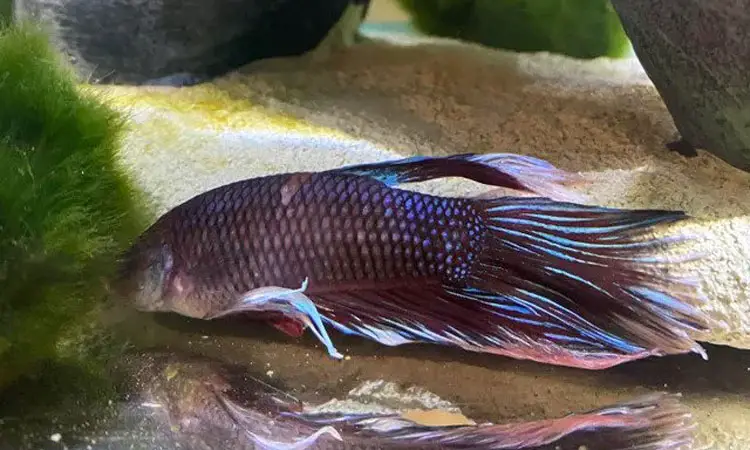
Once a high ammonia concentration has been detected, treatment of ammonia poisoning in betta must be done right away.
Water Changes
Firstly, you should go ahead and perform a 50% water change to lower the pH in the tank. Make sure the new water added is at the same temperature.
To avoid harming your betta with temperature shock while performing the water change, you should ensure that the new water’s temperature matches that of the water to be replaced.
Ammonia Detoxifier
Adding an ammonia detoxifier to treat your tank is the quickest solution to getting your tank back to normal. It works as a natural ammonia filter that uses an enzyme reaction to convert NH3 to NH4+.
Ammonia detoxifiers reduce the harmful levels of ammonia in your tank rather than getting rid of them altogether. The detoxifiers will reduce the negative effect of the ammonia and bring the levels down to a normal, healthy level, which will benefit the good bacteria in your tank.
Using an ammonia remover is especially helpful when used with a new tank. We recommend the API brand from Amazon. It’s less than $10 for the bottle and will last you a long time.
How To Prevent Ammonia Poisoning in Betta Fish
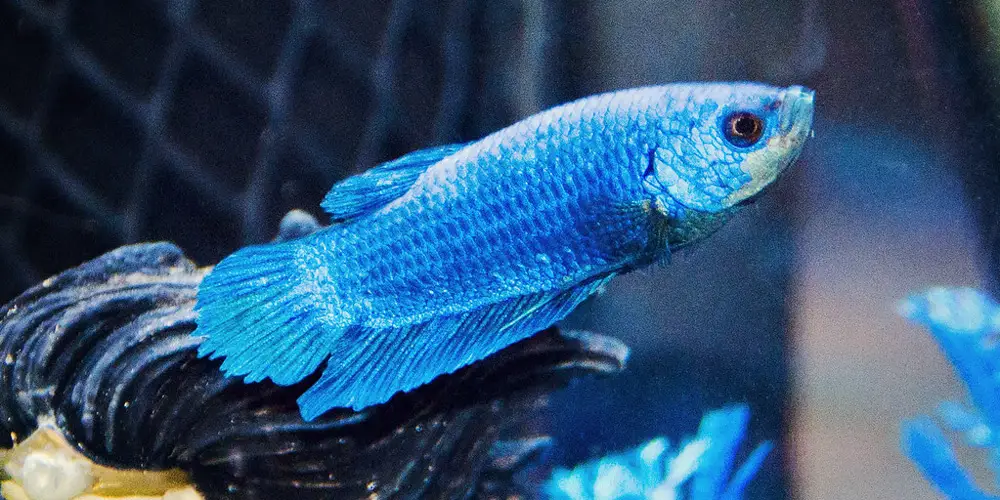
Preventative maintenance is always better than reactive maintenance. Meaning, you should do whatever you can to prevent ammonia poisoning before it happens rather than needing to treat it after it happens. Here are suggestions for the best preventative maintenance.
Frequent Water Changes: One of the most practical tasks you can perform for your fish tank is frequent water changes. Not only will it help to keep ammonia levels low, but it will also keep the water clean and safe for your fish.
Add Nitrifying Bacteria: The most important aspect of the nitrogen cycle in an aquarium is nitrifying bacteria. These bacteria help to convert NH3 or NH4+ into nitrite (NO2-) and then into nitrate (NO3-). API has a Quick Start Nitrifying Bacteria that is highly effective and only costs $15.
Add Ammonia Removal Inserts to Your Filter: One thing you can do to help prevent the buildup of harmful levels of ammonia in your tank is to add ammonia removal inserts to your current filter. As the water is filtered, the inserts will remove any traces of ammonia in the water.
We recommend the AquaClear Ammonia Removal Inserts from Amazon. They are inexpensive, coming in at less than $10 for a three-pack.
Water Filters: Bettas may be a tough breed, but they have basic everyday requirements that need to be met, just like any other fish. Some of those needs are a heater and water filter in their tank.
Don’t believe the myth that bettas can live in a fishbowl. They need at least a 15-gallon tank with a heater and a water filter. The filter will clean your betta’s tank while removing the ammonia buildup.
Frequent Tank Cleaning: Ammonia can be produced by decaying matter in your fish tanks, such as rotten food, fish waste, or plants. Regular tank cleaning and vacuuming of the substrate should eliminate any remaining debris from your tank.
Adding an Air stone: Air stones will help pump oxygen through your tank by creating flows of tiny bubbles that are then transported all over the tank oxygenating the water, which helps to disperse the ammonia that has begun to build up in your tank.
Air stones are not a necessary addition to your tank, but they are inexpensive to help keep your tank healthy. However, some bettas don’t particularly like them. You will need to test one in your tank to see if your bettas react positively to it.
Do Not Overfeed Your Betta: Not only will there be leftover food, but the more your betta eats, the more waste it will produce, which adds to the ammonia buildup.
Only feed your betta enough that they can eat all of it in less than two minutes. Any leftovers should be removed from the tank.
Buy a Reliable Test Kit: Once again, preventative maintenance can save you headaches later, as well as keep your fish healthy and safe.
An ammonia test kit is a great way to keep track of the level of ammonia in your tank. With regular testing, you’ll know right away if the ammonia levels have begun to rise, and you can act accordingly to reduce the levels safely.
Summary
Preventative maintenance is key in keeping your Bettas safe and healthy. Make sure you are doing your part by maintaining the tank, keeping it clean, and performing regular water testing and changes.
We hope this article has given you everything you need to keep your bettas safe from ammonia poisoning.
Article Sources:
- Aquarium Water Quality: Nitrogen Cycle [Florida Department of Agriculture and Consumer Services]
- Literature Review of Effects of Ammonia on Fish [Nature]
- Ammonia in Aquatic Systems [University of Florida]
- Viral Hemorrhagic Septicemia [Lowa State University]
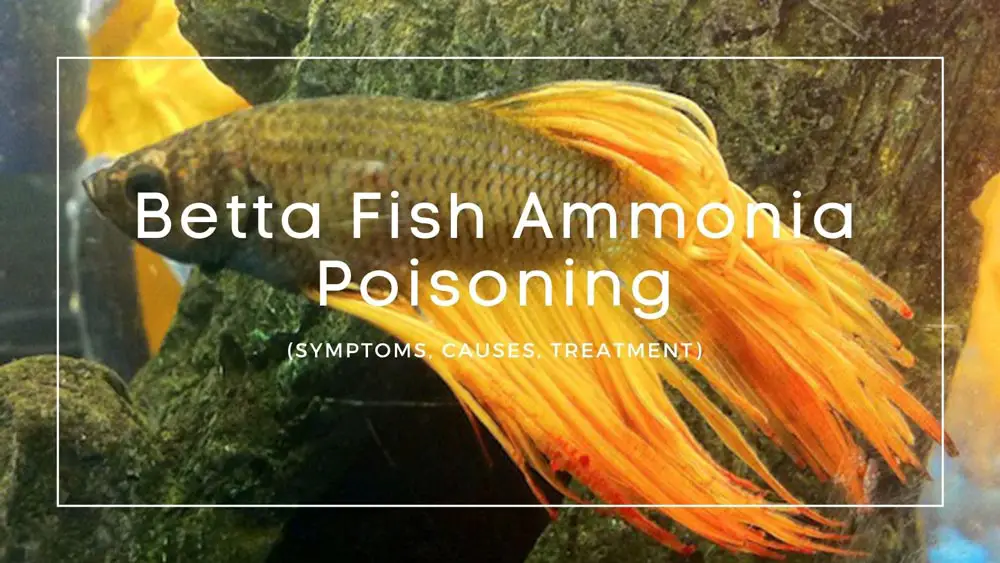
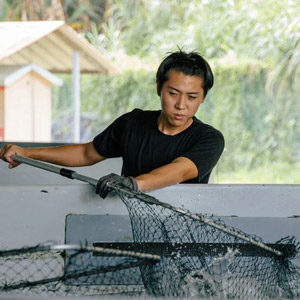




1 thought on “Betta Ammonia Poisoning: Causes, Symptoms & Treatment”
It looked as if my filter broke and dumped all the charcoal in the tank so he got very poisoned. I have for 3 wks done all I can, he is a fighter. I put him in a recovery tank, used betta fix and betta water conditioning. I excercise him 2x a day to get him to move for a minute or 2 and eat a few bites. Then he just lies down or holds to the filter. Since he is such a fighter I don’t want to give up. Is there anything else I can do? I have a small filter going thats gentle, he didn’t like the airstone, he has live plants from petsmart, and I’m changing the small tank every 3 days (temporary tank is small}. Thanks for any advice